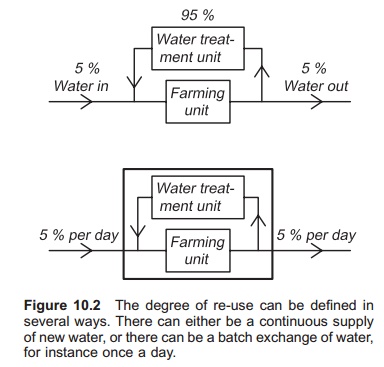Chapter: Aquaculture Engineering : Recirculationand Water Re-use Systems
Degree of re-use
Degree of re-use
Normally the degree of re-use (R) is used to give the percentage of the new incoming water (QN) in relation to the total amount of water (QT) flowing into the fish tank. This is described by the following relationship (Fig. 10.2):
R =(1−(QN/QT))×100
where:
R = degree of re-use
QN=new incoming water
QT=total water supply to the fish tank
= new incoming water + re-used water.

Example
If the supply of new water to a farm is 150 l/min and the total water flow is 1000 l/min calculate the degree of re-use.
R =(1−(QN/QT))×100
= (1 − (150/1000)) × 100
=85%
This, however, requires a continuous supply of new water, which also represents the normal way to operate a re-use farm.
Another way to operate a re-use system is to change the water in batches. This is the same as is done in aquaria, so information and knowledge from the operation of aquaria can be transferred to fish farming. However, in fish farming the emphasis is on optimal growth and this requires optimal environmental conditions; fish densities are also much higher. If the aim is for the fish to survive with some spare capacity, the requirement for water quality is reduced. For a re-use system that changes the water in batches, a given amount of water can be changed once a day or once a week, for instance. In this case the water quality will gradually decrease, until a new batch is exchanged and the quality returns to top level. In this case the degree of re-use can be expressed either as the percentage of water exchanged in relation to the total flow in the system throughout a day and night, or it can be given as the amount of water that is exchanged in relation to the total volume of water in the system (Fig. 10.2):
R =(1−(QB/QT))×100
where:
R = degree of re-use
QB=size of batch of new incoming water
QT=total amount of water flowing in the system between the exchanged batches of water.
R =(1−(QB/QT))×100
where:
R = degree of re-use
QB=size of batch of new incoming water
QT=total amount of water in the re-use system.
Example
The total amount of water in the system including the fish tank(s) and re-use circuit is 1000 l. The internal water flow in the system is 10 l/min. The amount of water in the exchange batch is 250 l and it is exchanged once a day. Calculate the degree of recycling based on both definitions.
R =(1−(QB/QT))×100
=(1 − (250/1000)) × 100
=75%
Total water flow in the system during a day: 10 l/min x 60 min x 24 h = 14 400 l.
R =(1−(QN/QT))×100
=(1 – (250/14 400) × 100
=98.3%
This example shows the importance of knowing which definition of re-use is used. Systems with continuous exchange of water and not batch systems are most commonly used.
Related Topics